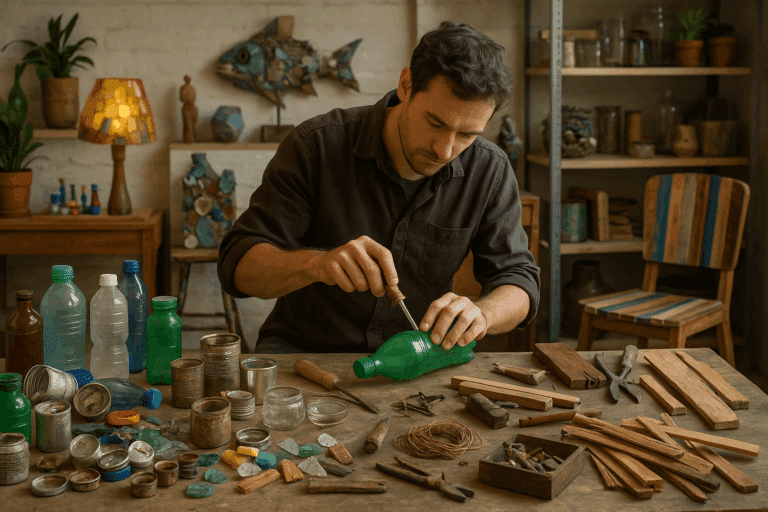Now, what if I told you that all these exquisite pieces were created from something you discarded last week? 😮 Yes, your trash! Welcome to the fascinating world of eco-art, where scrap materials are transformed into breathtaking artworks, reflecting the profound message of sustainability and environmental consciousness.💡
In this comprehensive guide, we will explore the beauty and complexity of eco-art, delving into its origins, significance, and the innovative techniques artists use to turn trash into treasure. As you journey with us through this narrative, you will discover the astonishing potential of scrap materials and the essential role they play in the eco-art movement. 🌍
Eco-art, also known as environmental art, can be traced back to the 1960s and 70s when artists began to draw attention to the growing environmental crisis. Today, it has become a powerful medium to address urgent ecological issues, including pollution, waste management, and conservation. But eco-art is not just about the message; it’s about challenging traditional art practices, pushing boundaries, and showcasing the beauty that can be found in the most unlikely of places – our waste. 🎨
The Journey of Scrap to Art
The transformation from waste to art is a complex, multi-step process. It involves sourcing materials, sorting and cleaning them, and then repurposing them in ways that breathe new life into what was once considered useless. The result? An innovative piece of art that is not only visually engaging but also loaded with significance. 🔄
Turning scrap into art requires a unique skill set that combines artistic talent with an understanding of materials and their potential. It is a process that requires creativity, patience, and a commitment to sustainability. From old car parts and broken electronics to plastic bags and discarded paper, artists use an array of materials to create eco-art that is as diverse as it is impressive. 🏺
Why Eco-Art Matters?
Eco-art is more than just a trend; it’s a movement. It not only challenges our perceptions of waste and recycling but also provokes thought about the broader implications of our consumption habits. By bringing our waste ‘back to life,’ eco-art provides a stark reminder of the damage we inflict on the environment and urges us to reconsider our actions. 🌳
Furthermore, eco-art can also play a significant role in educating the public about environmental issues. Through its visual impact and thought-provoking narratives, it has the power to spark conversations and inspire change. In a world facing pressing environmental challenges, eco-art provides a platform for artists to make a powerful statement about the state of our planet. 🌿
So, are you ready to embark on this exciting journey and discover the beauty of eco-art from scrap materials? Prepare to be inspired as we delve into the fascinating world of trash transformed into treasure! 🎉
Unraveling the Intricacy of Eco Art from Discarded Materials
In the world of innovation and creativity, artists have taken a step further to incorporate ecological consciousness into their works. Eco Art, also known as Environmental Art, showcases an interactive relationship between the artist and the environment. The concept extends to creating art pieces using waste materials, contributing to the sustainable approach of reusing and recycling. The creative art forms transform discarded items, often perceived as trash, into aesthetic and ecological treasures.
In this article, we delve into the fascinating world of Eco Art, exploring its evolution, its significance in today’s world, and how artists are using this medium to communicate strong messages about sustainability and environmental conservation. We also feature some incredible examples of eco-art created from scrap materials and draw comparisons between them.
One of the inspiring YouTube videos showcasing the transformation of waste into eco art is “Trash to Treasure: Amazing Art from Recycled Materials” by the channel ‘Great Big Story’. It provides an insightful look into how artists from around the world creatively transform discarded materials into magnificent pieces of art.
Exploring the Evolution of Eco Art
Eco Art is not a novel concept; its roots can be traced back to the Land Art movement of the 1960s and 70s. This art form has evolved over the decades, significantly influenced by increasing awareness of environmental issues. Artists began experimenting with natural elements and later expanded to discarded and recyclable materials. This shift was not just an exploration of new mediums but also a conscious attempt to address environmental degradation.
Eco Art has risen in popularity over the last few decades, with numerous artists and art enthusiasts recognizing its potential for sustainable expression. It is now a global movement with exhibitions and installations worldwide, spreading awareness about recycling and sustainability.
Witness the amazing journey of Eco Art in the YouTube video “The History of Environmental Art” by the channel ‘Articulations’. The video beautifully portrays how artists have used their creativity to highlight the pressing environmental issues over the years.
Significance of Eco Art in the Contemporary World
In today’s world, Eco Art plays a significant role in creating awareness about sustainability and promoting responsible behavior towards our environment. It serves as a creative means to address the escalating problem of waste disposal and the importance of recycling.
Moreover, Eco Art encourages the reuse of discarded materials, directly reducing the waste that ends up in landfills. The artistic transformation of these materials not only results in aesthetically pleasing artwork but also emphasizes the idea that nothing is waste until we waste it.
The insightful YouTube video “Why Eco Art Matters in Today’s World?” by the channel ‘Tedx Talks’ discusses the importance of eco art in promoting sustainability. It features various artists explaining how their art is contributing to environmental consciousness and change.
Transforming Trash into Treasure: Examples of Eco Art
Artists worldwide have been making significant contributions to the world of eco art by creating stunning pieces of art using discarded materials. Here, we feature a few incredible examples and draw comparisons between them based on the materials used, the creative process, and the messages conveyed.
| Artist | Art Piece | Materials Used | Message Conveyed |
|---|---|---|---|
| Tom Deininger | Monet’s Water Lilies | Discarded plastics | Highlighting the problem of plastic pollution |
| El Anatsui | Dusasa II | Recycled aluminum and copper wire | Communicating the potential of waste materials |
| Sayaka Ganz | Emergence | Discarded plastic utensils | Addressing the issue of waste disposal |
To delve deeper into their creative process and to see these eco art pieces, you can watch the video “Amazing Eco Artists” by the channel ‘Art Insider’. This video offers a behind-the-scenes look at how these artists transform waste into spectacular art pieces.
Conclusion
Eco Art is an innovative and inspiring field of art that has the potential to bring about a significant change in the way we perceive waste. It encourages us to see the beauty and potential in discarded materials, promoting the principles of sustainability and recycling. Whether you are an artist, an art enthusiast, or a concerned citizen, the world of Eco Art has something to offer you. So, let’s appreciate and support these creative endeavors and contribute to a more sustainable future.
Take Action: Start Your Eco Art Journey
Inspired by the world of Eco Art and want to start your own journey? Begin by exploring the vast world of eco art, from understanding the basics to seeking inspiration from renowned eco artists. You can even take up art courses focused on using recycled materials.
Remember, the first step towards creating eco art is changing your perception of waste. Start looking at discarded materials as potential resources for your art, and you are already on your way to becoming an eco artist. So, get creative, start experimenting, and embark on your journey in the fascinating world of Eco Art.
For a beginner’s guide on how to get started with eco art, watch the YouTube video “How to Create Eco Art?” by the channel ‘Eco Art TV’. This video provides useful tips and insights into creating eco art from discarded materials.

Conclusion
In conclusion, we have deeply delved into the complex world of IT and software engineering, exploring various topics that are integral to this intricate field. Throughout this article, we have tried to simplify and explain these multifaceted concepts, highlighting their significance and application in the current world. We began our journey by understanding the basics of software engineering, its importance in the development of functional and efficient software, and the vital role of a software engineer.
We further explored the different aspects of software development, including the various methodologies such as Agile, DevOps, and Waterfall, and their individual pros and cons. We discussed the important concepts of coding, debugging, testing, and maintenance, highlighting their significance in ensuring software quality and efficiency.
Additionally, we touched upon the various programming languages like Python, Java, and C++, stressing the importance of choosing the right language based on the project requirements. We also spoke about the significance of data structures and algorithms in software engineering, and how they can greatly impact the performance of software.
In the realm of IT, we delved into the different types of IT services like Infrastructure, Cloud, and Managed services, along with their benefits and challenges. We also explored the importance of IT in businesses today, and how it can help organizations achieve their goals.
Furthermore, we stressed the importance of continuous learning in these fields, given the rapid advancements in technology. We discussed various resources, like online courses, blogs, and books, that can aid in this learning process.
In essence, we underscored that IT and software engineering are no longer just fields of study or careers, but have permeated every aspect of our lives, making them indispensable.
Before we wrap up, let’s not forget the role that cyber security plays in all of this, protecting our data and systems from potential threats. In today’s digital world, where data is king, the importance of cyber security cannot be overstated.
We hope you found this article insightful and it was able to demystify some of the complex concepts in IT and software engineering. We encourage you to share your thoughts in the comments section below 👇 or share this article with others who might find it helpful 👥. If there are any other topics you’d like us to cover, feel free to suggest them.
We urge you to delve deeper into these subjects, and apply what you’ve learned in your own projects or work. Don’t forget, the key to mastery is continuous learning and application. Happy learning! 🚀
Sources:
1. Agile Alliance
2. DevOps.com
3. Python
4. Oracle Java
5. Gartner IT Services
6. Cyber Security Guide



